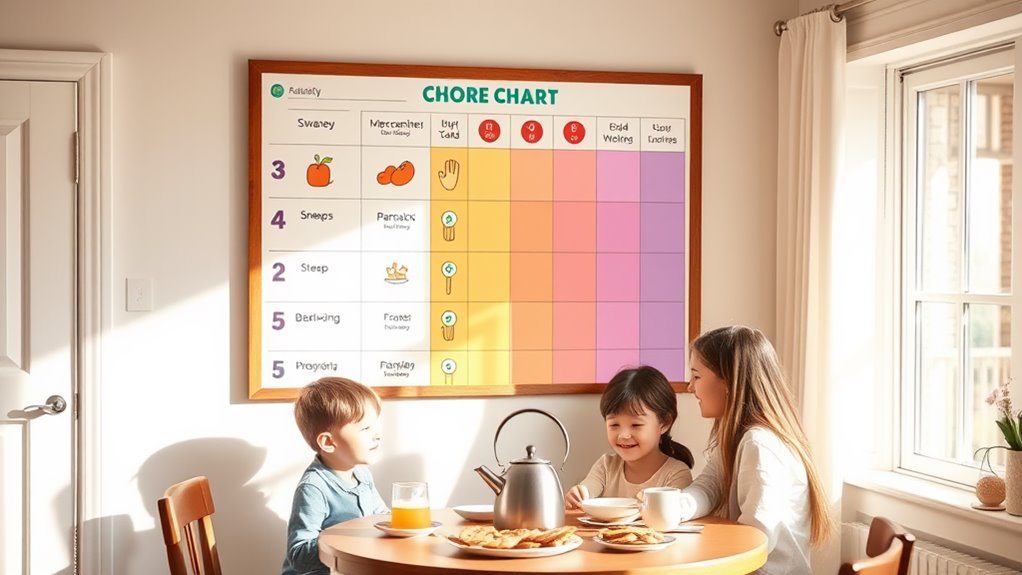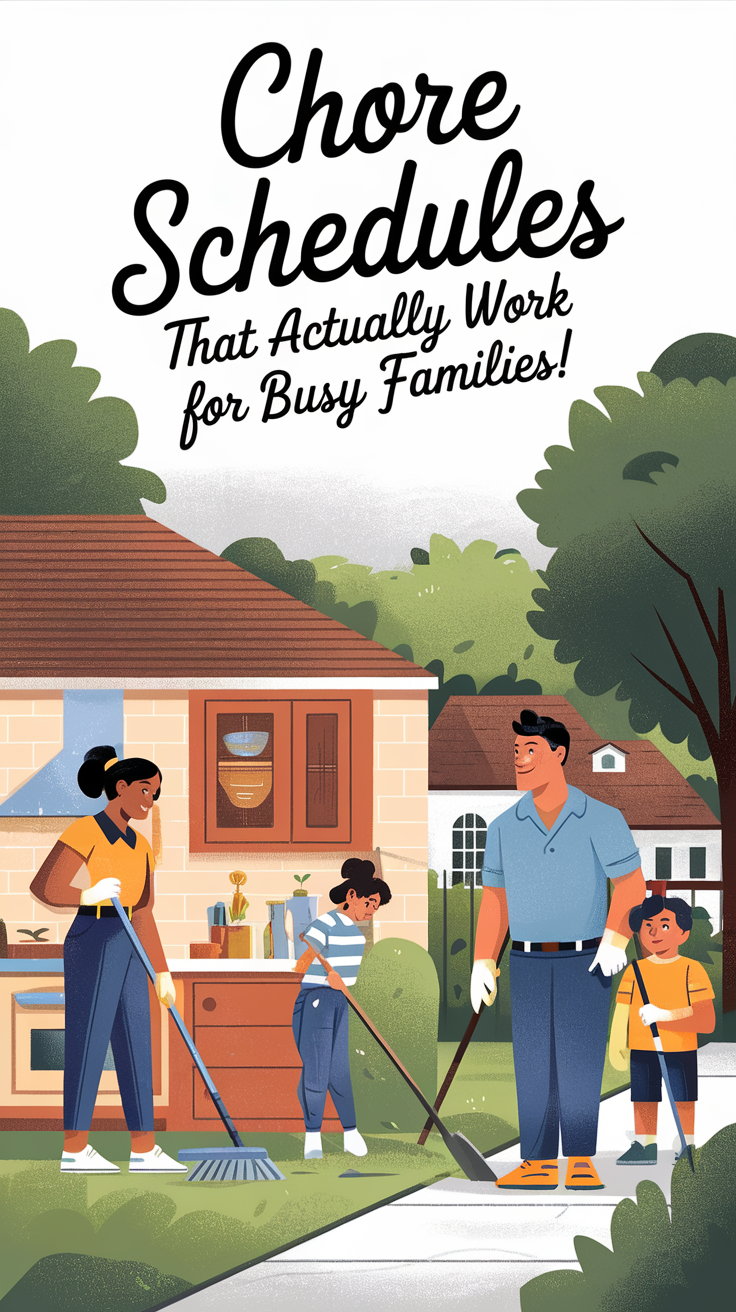The Perfect Chore Schedule for Families of All Sizes
To create the perfect chore schedule for your family, start by understanding each member’s strengths and preferences. Assign age-appropriate tasks, like simple chores for young kids and more complex ones for teenagers. Use customizable chore templates to accommodate varying schedules. For smaller families, rotate chores weekly to keep things fresh, while larger families can benefit from a chore chart that clearly outlines responsibilities. Don’t forget to hold regular family check-ins to discuss progress and make adjustments. By fostering teamwork and celebrating accomplishments, you can enhance motivation. Stick around to discover even more strategies for success.
Key Takeaways
- Assess family dynamics and individual strengths to assign age-appropriate chores for balanced participation across all family members.
- Create a customizable chore template that allows flexibility in task assignments to keep everyone engaged and accountable.
- Use a rotating schedule for small households to ensure variety and prevent monotony in chores.
- Implement a chore chart for large families, clearly outlining daily and weekly tasks to promote teamwork and accountability.
- Schedule regular family meetings to review progress, adjust assignments, and celebrate accomplishments to enhance motivation.
Understanding Family Dynamics
Understanding family dynamics is crucial, especially when you’re trying to establish a chore schedule that works for everyone. Each family member has their own personality, strengths, and weaknesses, which influence how they approach chores. You’ll need to take into account these factors to create a balanced schedule.
Communication is key; discussing preferences, availability, and even dislikes can help you find common ground. Pay attention to any existing routines or responsibilities that might affect participation.
It’s also important to acknowledge the changing dynamics as children grow or new members join the family. By fostering an environment where everyone feels heard and valued, you can develop a chore schedule that promotes teamwork and fairness, making household tasks more manageable and enjoyable for all.
Age-Appropriate Chores
When planning a chore schedule, it’s important to assign age-appropriate tasks that match each family member’s capabilities.
Young children can help with simple tasks like sorting laundry, picking up toys, or setting the table. As they grow, you can introduce more responsibility, such as making their beds or helping with meal prep.
Pre-teens can tackle vacuuming, dusting, and taking out the trash. Teenagers are ready for even more challenging chores, like grocery shopping, doing their own laundry, and preparing meals.
Customizable Chore Templates
Creating a chore schedule can be a breeze with customizable chore templates that fit your family’s unique needs. You can easily adjust tasks based on age, preferences, or even specific days. This flexibility helps everyone stay engaged and accountable.
Here’s a simple template to get you started:
| Day | Chore | Assigned To |
|---|---|---|
| Monday | Dishes | Child 1 |
| Tuesday | Vacuum Living Room | Child 2 |
| Wednesday | Laundry | Parent 1 |
| Thursday | Dust Surfaces | Child 1 |
| Friday | Take Out Trash | Child 2 |
Feel free to modify this table to accommodate your family’s routine and preferences. Customizing your chore templates can make the process more enjoyable for everyone involved!
Strategies for Small Households
For small households, implementing an effective chore schedule can feel a bit different than it does for larger families. With fewer people, it’s essential to optimize your efforts and guarantee everyone contributes.
Start by listing all chores and dividing them based on preference and ability. Create a weekly schedule that rotates tasks, so everyone gets variety and shares the load.
Consider using a shared app or a physical calendar to keep track of responsibilities. Don’t forget to set aside time for a family meeting to discuss progress and adjust assignments as needed.
Celebrate accomplishments together, reinforcing teamwork and motivation. With these strategies, you’ll maintain a clean, organized home while fostering a sense of shared responsibility.
Managing Large Families
Managing a large family can feel overwhelming, especially when it comes to chores. To tackle this, start by dividing responsibilities among family members based on age and ability.
Create a chore chart that outlines daily and weekly tasks, ensuring everyone knows their role. Make it a family event by involving everyone in the process—assigning tasks can help build teamwork and accountability.
Consider rotating chores weekly to keep things fresh and fair. Utilize a rewards system to motivate your kids; small incentives can go a long way in fostering enthusiasm.
Finally, hold family meetings to discuss the chore schedule, making adjustments as needed. This approach not only keeps your home organized but also strengthens family bonds through shared responsibilities.
Multi-Generational Home Solutions
While living in a multi-generational home can present unique challenges, it also offers a fantastic opportunity for families to strengthen their bonds and support one another.
To make the most of this arrangement, it’s important to establish clear communication and share responsibilities. Create a chore schedule that outlines tasks for each family member, considering everyone’s abilities and preferences. This not only fosters accountability but also guarantees that everyone contributes.
Designate specific areas of the home for each generation, allowing everyone to maintain their space while still being together. Regular family meetings can help address any issues that arise and celebrate accomplishments.
Ultimately, embracing flexibility and understanding will create a harmonious environment that benefits all generations involved.
Tips for Successful Implementation
Creating a chore schedule is just the beginning; implementing it successfully requires commitment and collaboration from everyone involved. Start by discussing the schedule with your family, ensuring everyone understands their responsibilities and the importance of teamwork.
Make it visually appealing—use a chart or a digital app to track progress and celebrate achievements. Consistency is key; stick to the schedule as closely as possible, but be flexible and willing to adjust if needed.
Regular check-ins can help address any concerns or frustrations. Encourage open communication and positive reinforcement to keep everyone motivated.
Finally, lead by example; when you show commitment to the schedule, your family is more likely to follow suit. Success comes from everyone working together!
Frequently Asked Questions
How Can We Motivate Reluctant Family Members to Do Chores?
To motivate reluctant family members, try making chores fun by turning them into games or challenges. Offer small rewards, share responsibilities fairly, and emphasize teamwork. You’ll create a more positive atmosphere and encourage participation.
What Tools or Apps Can Help Manage Our Chore Schedule?
To manage your chore schedule effectively, consider using apps like Todoist, Cozi, or OurHome. These tools help you assign tasks, set reminders, and track progress, making it easier for everyone to stay organized and accountable.
How Often Should We Reevaluate Our Chore Schedule?
You should reevaluate your chore schedule every few months or whenever circumstances change, like new family members or shifting responsibilities. Regular check-ins keep things fair, ensuring everyone stays engaged and the workload remains balanced.
What Rewards Work Best for Completing Chores?
Rewards like extra screen time or a favorite treat work best for motivating you to complete chores. You’ll feel accomplished, and those incentives can turn a mundane task into something enjoyable you look forward to.
How Can We Handle Disputes Over Chore Assignments?
To handle disputes over chore assignments, communicate openly. Encourage everyone to share their concerns and preferences. You can negotiate adjustments and find compromises, ensuring everyone feels heard and valued in the decision-making process.



